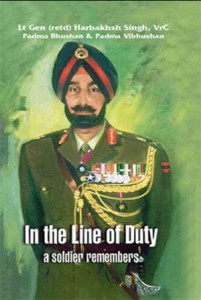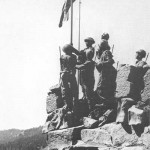For the night of the 9th/10th of September, and the next day, when 4 Mountain Division was hard pressed by the Pakistani Ace Armoured Division (with Patton tanks, that had night-vision sight), the Sikh Company (17 Sikh) played a stellar role, against the Pakistan armour, in the defence of Asal Uttar road-junction.
Late at night on the 9th of September, the Chief of the Army Staff, rang me up to say that he had read Corps Commander XI Corps’ letter sent to me, and that his advice was that to save the whole Army from being cut off by Pakistan’s Armour push, I should pull back to the line of the river Beas. I was aghast at this suggestion and said that since it was a tactical order, he had to come to the Frontwith me to give it, or else he had to issue an Operations Instruction, as is the custom in the Army. His reply was that I should stay put at my Headquarters till the next day as he was coming to see me. The next morning, at about 10 am, I went to meet the Chief at the airfield at Ambala, and was surprised to see that his -aircraft had a fighter escort. I remarked on this to the Air Force Station Commander, pointing out that our forward troops were crying out for these aircraft every day. The Chief and I went straight into my Operations Room, and we had a very heated discussion. He got so excited at one stage that I suggested that I get him a bottle of beer from the Mess – as he was going to have lunch with us, in any case. He welcomed. this, but I had already made it quite clear to him that if he wanted to give me a tactical order, then he would have to come to the Front with me, and only then would I decide whether I would carry it out or not. He left for Delhi by air after lunch and I left for my’ Operations Room, to follow the Divisional Battle with Pakistan’s Armour.
Early on the morning of the 11th, I left in a jeep for the 4 Division area. I had a camouflage coat on, over my uniform, and was driving the jeep myself. Just beyond Bikhiwind, I noticed a couple of artillery vehicles, standing nose to tail and camouflaged with a net. They were loaded with artillery ammunition, and were on fire, having been strafed by the Pakistani planes, which were still flying overhead. As the ammunition was on fire, shells were exploding all round. I observed a few Sikh peasants hoeing the cotton-crop near by al1ddecided to warn them of the danger they might face from exploding shells. After I delivered my warning, the eldest amongst them looked at me and said: “Sardar Sahib, you seem to be new to this place; for this happens every day here”. He then asked me if I was a farmer’s son. If I was, then I should know that the soil was just wet-enough for hoeing that day and that by tomorrow, it would be hard as stone, “Please do not worry about our safety; you do your work and we shall do ours,” was his parting shot. I was wonder-struck at their attitude, and felt a sense of awe.
I returned to my jeep, and a little further on saw a farmer pulling a 1000 lbs air-bomb (a dud it seemed) behind a pair of bullocks. Upon being questioned, he said that the Pakistanis had dropped this on his field, and since he needed to plough it, he was moving it near the road, where the Government, to whom the thing belonged, could take it away! As’! watched, he unhitched the bomb and left it near the side of the road! While entering the village of Dibipura, where the battle with the enemy arm our had taken place earlier, I noticed a few peasants sitting on charpoys in the courtyard of the village. I went up to them and they all stood up to receive me and offered me a seat, and would not sit down until I had. I asked them how they were still there considering the big battle that had been fought in their neighbourhood.
Late at night on the 9th of September, the Chief of the Army Staff, rang me up to say that he had read Corps Commander XI Corps letter sent to me, and that his advice was that to save the whole Army from being cut off by Pakistans Armour push, I should pull back to the line of the river Beas.
They answered in unison, “How could we leave our village; yes, of course, we sent our families and children away, but there was no danger for us while your troops were next door to us.” In fact, they had seen the entire battle that had been waged between opposing tanks from the roofs of their houses. There had been a lot of noise, but at no point had they felt personally threatened.
I bade farewell to them and went over to the Headquarters of the Cavalry Unit (Centurions) that had inflicted the most damage on the Patton tanks that had been ranged against them. I met their. Commanding Officer, Lt Col Calif. He showed me the Patton tanks that they had captured intact and brought over to our side. The Sikh Dafedar who was showing me the Patton tanks and who later offered to give me a ride in one of them, was like a child with a new toy. He could not stop talking about the computer, the range-finder, the electrically movable turret, and so on, in the Patton tank. When I jokingly asked him how he had beaten such a formidable machine with his old Centurion, his reply was, “It is true, this tank, the Patton, is a Rolls Royce and my tank is a T-Ford.
I might not have a computer or a range-finder in my tank, but my training in the Centurion has been such that I can hit a fly at a 1000 yards range, and these Pattons came out of a sugarcane field only at 500 yards range!” Consequently, he explained, he was able to put two shots into each one of the Patton tanks even before they could train their guns on him. And he was absolutely right. I have never seen so many tanks destroyed, lying there in the battlefield like abandoned toys. As I was walking through the fields and looking at these destroyed tanks, with Calif and many others behind me, a young man, dressed in civilian clothes – a pair of blue trousers, a blue-chequered shirt, with the top button open and a blue tie tied loosely around his neck (in the American style)-suddenly emerged from the crops, saluted me and said that as I seemed to be a very senior officer he had come to surrender as a prisoner-of-war. I asked him his name and he replied: Sawar Anwar-ul-Haq of 4 Horse, Pakistan Army. I then asked him why he was dressed as a civilian?
Also read: Defence Purchases: time India asserts itself
He pointed to his tank standing near by and explained that since the leading tanks after being hit had caught fire, he had abandoned his tank fearing that the same fate awaited him. “And, as you know, Sir”, he .continued, “as a Muslim I did not want to burn to death, so I changed in the tank into civilian clothes hoping to escape. But since I find that I am surrounded on all sides, I have come to surrender.” He further mentioned that the Pakistanis believed that we (Indians) had a certain ‘Baba’ (holy man) who had ‘keeled’ (consecrated) the shells in our tanks in such a manner that when they hit steel they burned right through it.
 The ‘Baba’, of course, was Bhabha, the Chairman of the Atomic Energy Commission! As I had no desire to change his belief, nor that of the rest of the Pakistanis, I kept this information to myself and instead all I said in reply was, “Oh, so this fact has also reached you?” On my return to Dibipura, after inspecting the battlefield, I saw that the Pakistani prisoner-of-war had become the centre of attention. There was a circle of men sitting around him and he was being fed with puries and tea. I pointed this out to Calif and asked: “Is this the way to treat a prisoner?” I asked that he be blind-folded and sent to the rear.
The ‘Baba’, of course, was Bhabha, the Chairman of the Atomic Energy Commission! As I had no desire to change his belief, nor that of the rest of the Pakistanis, I kept this information to myself and instead all I said in reply was, “Oh, so this fact has also reached you?” On my return to Dibipura, after inspecting the battlefield, I saw that the Pakistani prisoner-of-war had become the centre of attention. There was a circle of men sitting around him and he was being fed with puries and tea. I pointed this out to Calif and asked: “Is this the way to treat a prisoner?” I asked that he be blind-folded and sent to the rear.




